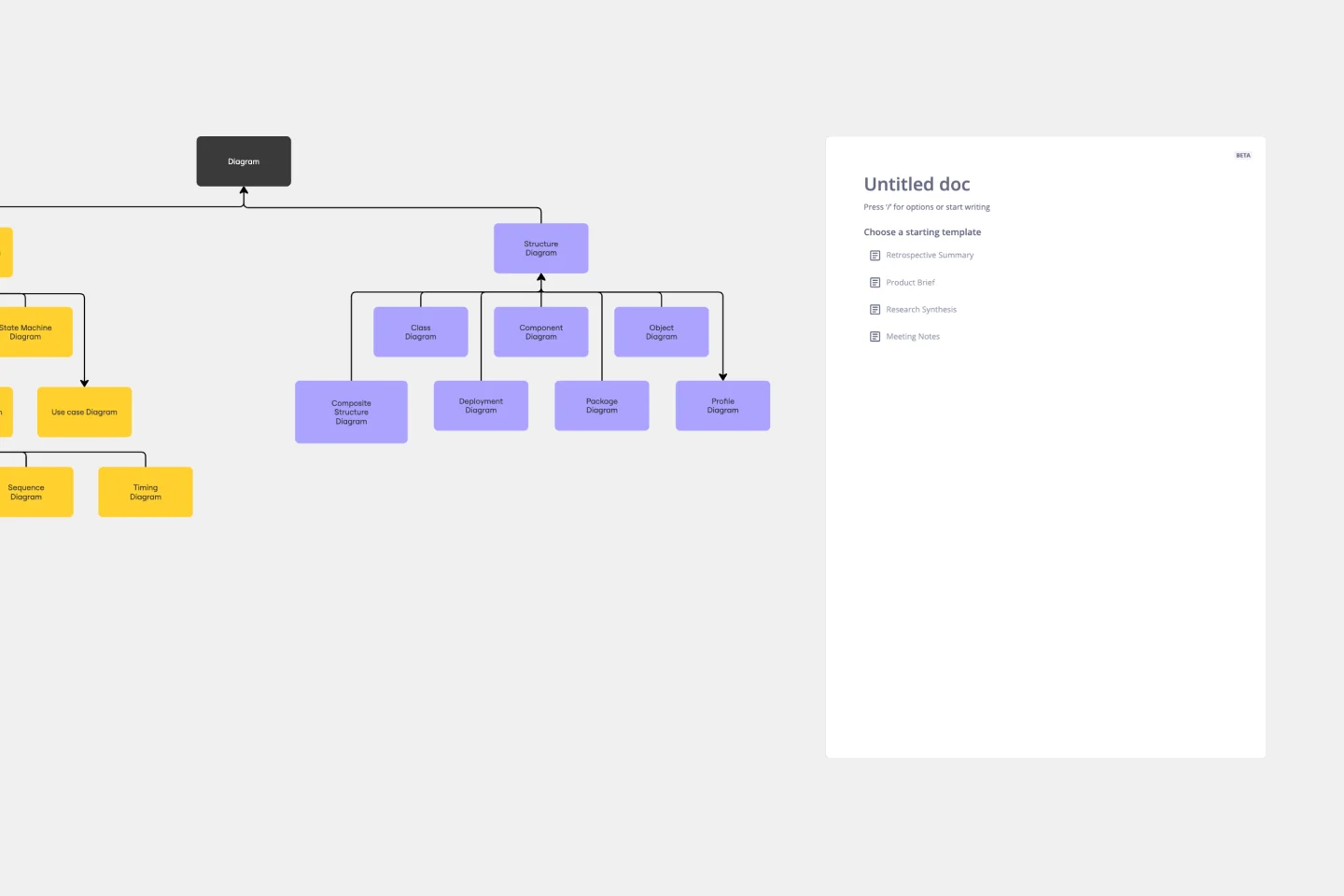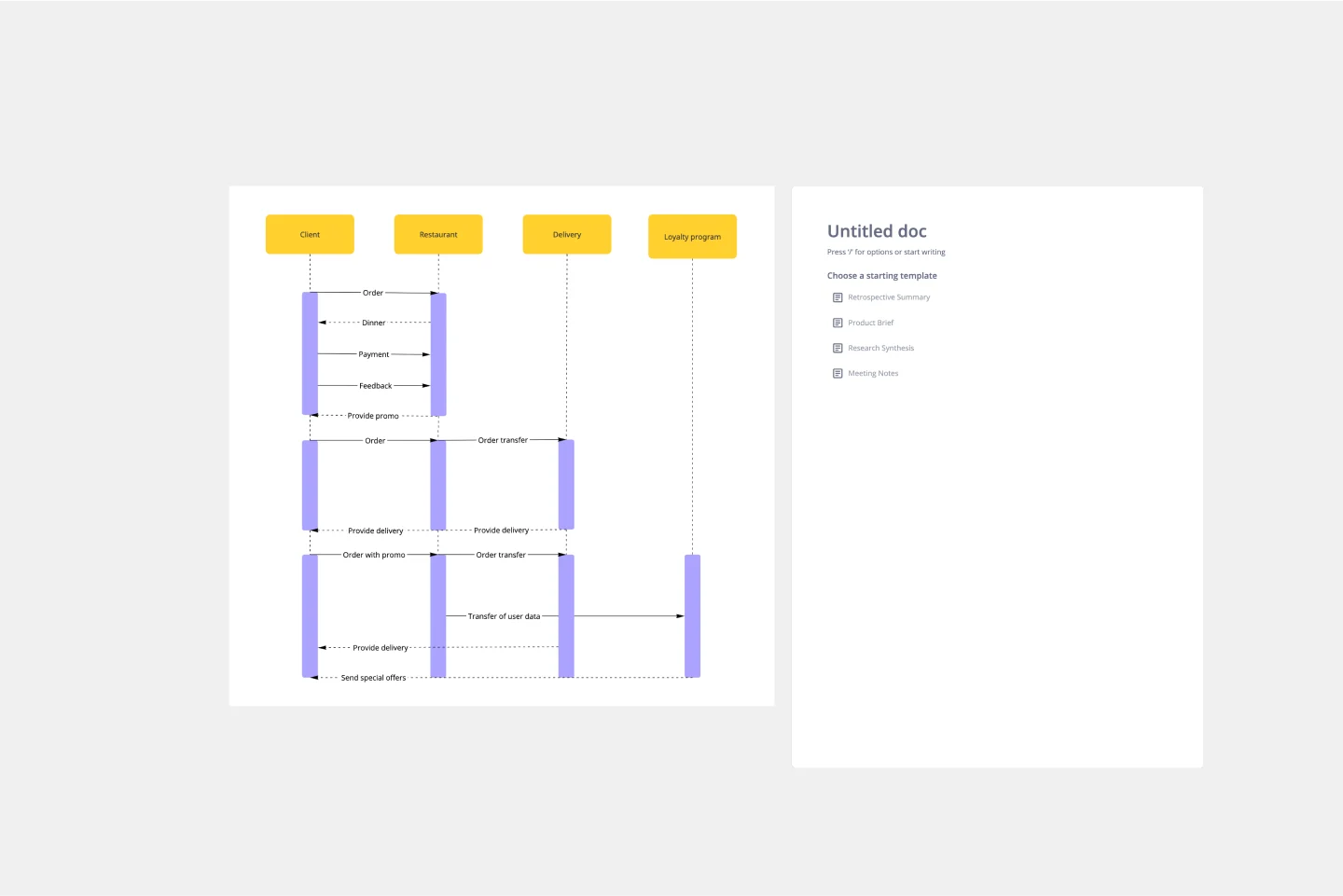About the UML Class Messaging System Template
The UML Class Messaging System Template is designed to fully visualize a messaging system's functionality. This template helps in managing various aspects of a messaging system, including text messages, conversation threads, user contacts, notifications, and channels. It provides a clear visual representation of how all these elements interact within the system, making it an invaluable tool for system designers and developers aiming to understand or convey the structure and dynamics of messaging systems.
How to use the UML Class Messaging System Template
Edit the template: After adding the template to your board, you can start customizing it to fit your specific project needs. You can modify the classes, attributes, methods, and relationships to accurately represent the messaging system you are designing or analyzing.
Collaboration: Invite your team to collaborate on the diagram in real-time or asynchronously. Discuss, edit, and refine the diagram together, ensuring a comprehensive understanding and agreement on the system's design.
Review and iterate: Use Miro's commenting to gather input from stakeholders or team members. Iterate on the design as needed based on the feedback received to ensure the final diagram accurately represents the intended messaging system architecture.
Why use the UML Class Messaging System Template
Using the UML Class Messaging System template in Miro has several advantages:
Efficiency: Quickly get started with a structured visual representation, saving time on initial setup.
Clarity: Provides a clear and detailed overview of the messaging system's architecture, making it easier to identify potential issues or improvements.
Collaboration: Facilitates effective team collaboration and stakeholder engagement, ensuring all voices are heard and considered in the design process.
Flexibility: Easily customizable to fit the unique requirements of your project. Whether you're designing a simple messaging app or a complex communication platform, the template can be adapted to suit your needs.
Visual clarity: The template provides a visual framework that simplifies the understanding of complex messaging systems. By mapping out classes, attributes, methods, and relationships, stakeholders can easily grasp how different components interact.
Improved communication: It serves as a common language for developers, designers, and stakeholders, facilitating clearer communication. The visual representation helps in bridging the gap between technical and non-technical team members, ensuring everyone is aligned.
Error reduction: Early visualization of the system architecture can help identify potential issues or inefficiencies, reducing errors in the development phase. This proactive approach saves time and resources in the long run.
Documentation and reference: The completed diagram can serve as valuable documentation for current and future development efforts. It provides a reference point for understanding the system's structure and can be used to onboard new team members or guide future expansions.

Miro
Your virtual workspace for innovation
Miro is an innovation workspace designed for teams of every size, everywhere, to dream, design, and build the future together. Our mission? To empower these teams to create the next big thing, powered by AI at every step of the way. Over 90 million users around the world rely on Miro to untangle complex ideas, put customer needs first, and deliver products and services faster. All supported by best-in-class security, compliance, and scalability.
Categories
Similar templates
UML Diagram Template

UML Diagram Template
Originally used as a modeling language in software engineering, UML has become a popular approach to application structures and documenting software. UML stands for Unified Modeling Language, and you can use it to model business processes and workflows. Like flowcharts, UML diagrams can provide your organization with a standardized method of mapping out step-by-step processes. They allow your team to easily view the relationships between systems and tasks. UML diagrams are an effective tool that can help you bring new employees up to speed, create documentation, organize your workplace and team, and streamline your projects.
UML Class Diagram Template

UML Class Diagram Template
Get a template for quickly building UML class diagrams in a collaborative environment. Use the UML class diagram template to design and refine conceptual systems, then let the same diagram guide your engineers as they write the code.
UML Sequence Diagram Template

UML Sequence Diagram Template
Analyze and showcase how external entities interact with your system using a sequence diagram. Get a bird’s-eye view of your work processes, business functions, and customer interactions using this diagram. Also, identify any potential problems early and solve them before implementation.
UML Diagram Template

UML Diagram Template
Originally used as a modeling language in software engineering, UML has become a popular approach to application structures and documenting software. UML stands for Unified Modeling Language, and you can use it to model business processes and workflows. Like flowcharts, UML diagrams can provide your organization with a standardized method of mapping out step-by-step processes. They allow your team to easily view the relationships between systems and tasks. UML diagrams are an effective tool that can help you bring new employees up to speed, create documentation, organize your workplace and team, and streamline your projects.
UML Class Diagram Template

UML Class Diagram Template
Get a template for quickly building UML class diagrams in a collaborative environment. Use the UML class diagram template to design and refine conceptual systems, then let the same diagram guide your engineers as they write the code.
UML Sequence Diagram Template

UML Sequence Diagram Template
Analyze and showcase how external entities interact with your system using a sequence diagram. Get a bird’s-eye view of your work processes, business functions, and customer interactions using this diagram. Also, identify any potential problems early and solve them before implementation.